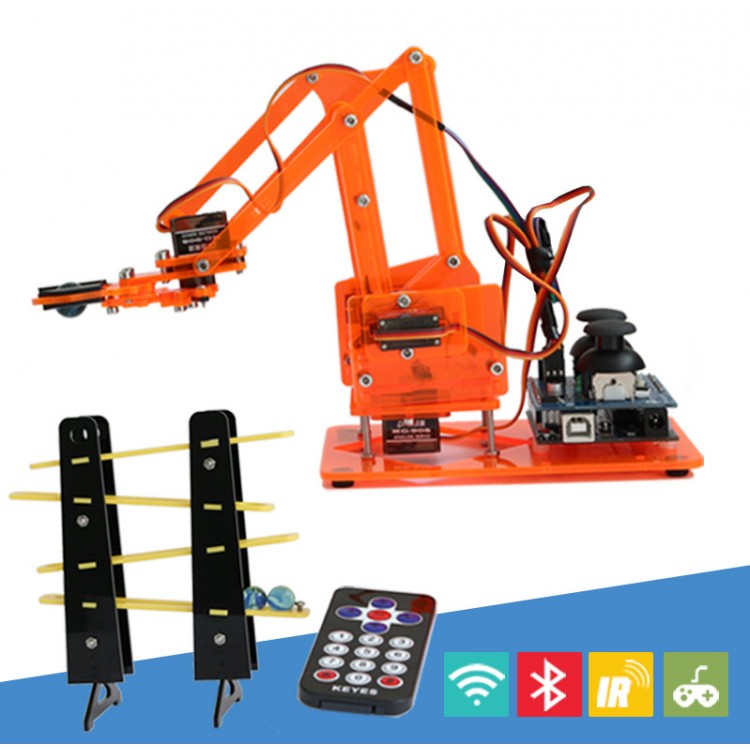
- #ARDUINO ROBOT ARM KIT HOW TO#
- #ARDUINO ROBOT ARM KIT INSTALL#
- #ARDUINO ROBOT ARM KIT CODE#
- #ARDUINO ROBOT ARM KIT WINDOWS#
#ARDUINO ROBOT ARM KIT INSTALL#
4.1.2 (2) Then install the control board, and prepare the components as follows:.4.1.1 (1) Firstly, you should prepare the components as follows:.4.1 Step1: Begin with the Baseplate Assembly.While(Serial.available()>0) dump = Serial.read() // dump buffer Serial.println(String("Update: " + readServoPositions())) Servo servo_0,servo_1,servo_2,servo_3,servo_4,servo_5 // create servo objects to control a servo
#ARDUINO ROBOT ARM KIT CODE#
Do not power up motors before uploading the software, because you still need to calibrate them to their default positions.Ĭopy code //Arduino Robotic Arm Control Spftware Measure the voltage with a DMM if the board doesn’t have an on-built display.ĭo not use voltage regulators for this sake or in any project that requires voltage regulation at high currents, because basic zener voltage regulators like the LM7805 don’t generate current gain and therefore are very inefficient and will heat up quickly. The XL4015 based circuits are very efficient as they lower the voltage and raise the current to the load at a 90% efficient rate. We’ll need a module that is capable of supplying 4A peak current. I’m using a 12V lithium battery connected to a DC-DC step down BUCK converter. Powering up the system from a USB cable is not enough. This way it is easier to connect the servos using their 3-pin female connectors. I recommend using a shield compatible with all the I/O pins that provides parallel power lines to which you can solder regular pins. The control wires which are colored orange or yellow go to the PWM pins of the Arduino. Connect all of the servo motors to power in parallel. I personally duck-taped the base of the arm to a brick and it worked fine. Because when it’ll move it’ll have a high impulse so to avoid falling upside-down the arm has to be fixed to a stable platform to support it. When assembled, install the arm on the fixed foundation.
#ARDUINO ROBOT ARM KIT HOW TO#
See the image to get a clearer view on how to place the motors. Also, if the 3-wire cable is not long enough to reach the ground when the arm is fully stretched, you will have to cut the cable and add more wire to it.
#ARDUINO ROBOT ARM KIT WINDOWS#
Because it will affect the direction to which the arm will move, so far as the spin of the motors is controlled by a windows application stays constant.

While assembling the motors, pay attention to the side that motors 1, 2 and 3 are facing. Fasten the bolts tightly to minimize dangling parts – but not too tight! So I eventually extended the flexibility and range of my robotic arm.Īssembling the arm should be done carefully and can take an hour or two.

So at this occasion I chose the DMS15-270 motor which has a wide 270 degree range rather than the more common MG996R that reaches up to only 120. However, the advantage of ordering the parts separately is the flexibility of choosing the motors that will be used in the project. In my case, I ordered the kit and then realized it did not include the motors and the disks. Some 6DOV DIY robot arm kits come with all relevant parts (aluminum bits, servo disc and servo motors) included, while others don’t. To do so, robots must have similar autonomy consisting moving parts that are electromechanically driven and a “brain” component to control them by following pre-determined instructions, or make them make up on its own! So current technology allows us to build machines that are capable of performing human-like actions. Electricity and computer science provided the gateway to something new – robotics! Automized machines capable of human activity. Since the beginning of the industrial revolution mechanical engineers developed machines to ease on the workforce. It makes products cheaper to produce and at larger quantities making the technology worthwhile to invest in. A remarkable technological advancement that pushes mankind up a step in the ladder of industry tech. Automation is stated to be the 3rd phase of the industrial revolution. Automation is one of the leading development fields mainly because it advances the industry further than ever before, providing the potential of almost fully automated production lines.


 0 kommentar(er)
0 kommentar(er)
